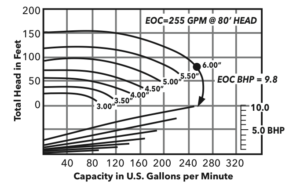The Basics of Centrifugal Pump Curves
Look to any industry, private or public, that relies on the transfer of fluids, and it’s more than likely that those fluids will be delivered by a centrifugal pump. They are the backbone of any water distribution or wastewater collection and management system, as well as applications as diverse as flood and fire protection, drainage, irrigation, boiler feeds, and much more. Knowing the correct size pump for an application requires knowing the answer to one fundamental question: what is a pump curve?
Understanding performance and horsepower requirements for pump applications is essential for engineers and operators alike. Calculating the pump curve will provide the necessary data to select the correct size pump with enough power to ensure effective conveyance, efficiency, energy cost-savings, but also to meet any specific working or environmental conditions.
The Importance of Pump Sizing
Knowing the correct size of a centrifugal pump matters. Depending on the application - they are used in any industrial, agricultural or domestic environment that requires the flow of relatively low viscous liquids - water, oils, acids, solvents, organics, bases, liquid foods, and so forth. Centrifugal pumps also power municipal water supplies for towns and cities around the globe. The health and welfare of communities truly relies on a centrifugal pump to deliver clean water in and wastewater out of homes and buildings. These pumps must operate every hour of every day of the week, month after month and year after year. An incorrectly sized pump will underperform or fail if the device is too small or prove too costly if it’s too large.
Because the range of applications are so extensive, pumps come in multiple styles, and in various sizes with different capacities. When choosing a pump, the pressure and volume requirements of the specific operation for which the pump is needed must be considered. Necessary horsepower requirements for volume and discharge pressure must also be factored in. To ensure that the pump selected has a long service life and operates at maximum efficiency, then reading and comprehending a pump curve for a specific application is essential.
What is a Pump Curve?
To select a pump for a system, engineers measure a pump’s performance capabilities by plotting a pump curve. Pump curves are graphical representations of a given pump that, once calculated, provides the necessary information regarding the performance characteristics and capabilities that will be required of that pump. Using an x-y graph, in most instances, the measure of head pressure will be represented on the vertical axis and the flow capacity will be represented on the horizontal axis in GPM (gallons per minute). Keep in mind, when viewing pump flow charts, units are measured as gallons and feet in the U.S., and liters and meters throughout the rest of the world.
How to Read Centrifugal Pump Curves

Find the highest point of a pump curve on the left and note the line's gradual curve down to the right. Moving left to right, the curve shows differing amounts of flow and pressure until the curve ends. Note the x-y points of intersection. Each intersecting point on the curve shows the flow rate the pump produces at a certain level of pressure to achieve a desired height when the pump is in operation. Conversely, the pressure the pump works at also demonstrates a certain flow rate.
Horsepower (HP) requirements for pump applications are also represented on pump curves. When reading a curve, horsepower shows how much power the pump requires to operate efficiently at any particular flow point. This ensures the motor selected is the correct size for the application and also useful to calculate power consumption costs. Units to measure horsepower are represented in kilowatts.
Pump curves are essential data that provides engineers and operators the performance and power requirements for a given pump. Understanding pump performance informs operators how quickly a given pump can move liquid as represented in GPM, how much energy the pump must create to compensate for any losses in the fluid delivery, and the necessary horsepower required to operate the pump. Ultimately, pump curves will ensure that the correct pump for the application is selected.




